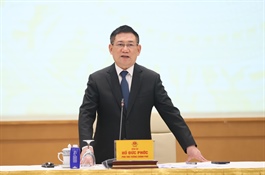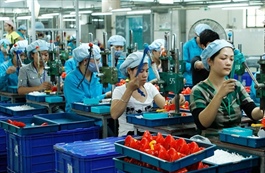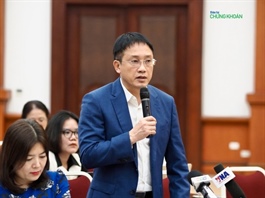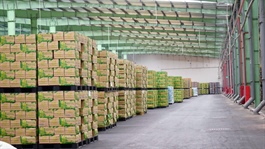Vietnam strives to alleviate US tariff plan
Vietnam strives to alleviate US tariff plan
Vietnam’s leaders are mobilising to respond effectively to the new tariff rates imposed by the United States last week.
US President Donald Trump unveiled his global reciprocal tariff plan on April 2 and rattled Vietnam with a 46 per cent tariff rate on Vietnamese imports. This is the highest rate among major trading partners worldwide, though neighbouring nations were badly affected, with the rates for Laos and Cambodia sitting at 48 per cent and 49 per cent, respectively.
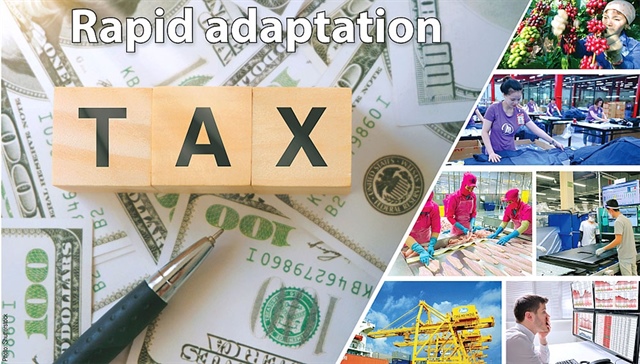
Vietnam strives to alleviate US tariff plan |
The move represents the most protectionist shift in US trade policy in recent memory, and Vietnam stands in the firing line. Vietnam is one of the US’ key trade partners, with exports to the market reaching around $120 billion last year.
The rates do not become effective until April 9, meaning Vietnam’s government – along with every other country and territory – have had little time to scramble a response.
Minister of Industry and Trade Nguyen Hong Dien sent an official letter requesting the US to postpone the tariff decision to allow time for discussions and to find reasonable solutions for both sides. Efforts are underway to arrange a phone call between the two sides and technical-level discussions with colleagues at the US Trade Representative as soon as possible, the ministry said.
Right after the announcement from the White House, Prime Minister Pham Minh Chinh also held a meeting with all leaders of ministries and government agencies to discuss a timely and suitable response.
The PM immediately established a rapid response team led by Deputy Prime Minister Bui Thanh Son, while DPM Ho Duc Phoc is directing ministries and government agencies to organise meetings and listen to the voices of businesses, including large exporters.
“We have some experience in surviving and overcoming dire challenges such as the coronavirus pandemic, global conflicts, and supply chain disruptions,” the PM said. “Trade competition is getting fiercer and more unpredictable. Vietnam hopes that the US will provide a policy consistent with the good relations between the two countries, the wishes of the people on both sides, and the efforts of Vietnam in recent times.”
Deputy Minister of Finance Nguyen Duc Chi told VIR, “We will persevere to discuss and negotiate with US trade partners, aiming for a trade balance so that consumers of both countries can benefit, following the efforts of Vietnam to balance the trade with the US in recent months. We hope that the US side will listen and take appropriate steps, and the tax rate will be considered.”
It was reported last week that DPM Phoc will visit the US on April 6-14 to try and renegotiate a deal. Executives from Vietnam Airlines and Vietjet will also reportedly visit New York to meet with Boeing about potential deals.
The Ministry of Finance (MoF) said that 46 per cent is much higher than the current tax rate on Vietnamese goods exported to the US.
“The new tariff from the US will negatively affect many Vietnamese manufacturing industries,” said Truong Ba Tuan, deputy director general of the MoF’s Department of Tax, Fees, and Charges Policies. “Particularly, five main industry groups accounting for 64.3 per cent of total export turnover to the US in 2024 will be most affected by this tax imposition.”
The main industry groups are electronics and various components, accounting for 28.6 per cent of total export turnover; textiles, garments, and footwear making up 21.9 per cent; wood and wooden products capturing 7.6 per cent; agriculture and seafood at 3.5 per cent; and steel/aluminium at 2.7 per cent.
Meanwhile, Chu Thanh Tuan from the RMIT University Vietnam’s Undergraduate Business Programme said, “With nearly 30 per cent of Vietnam’s total exports destined for American consumers, the introduction of such tariffs could erode price competitiveness, trigger order cancellations, and compel businesses to either absorb margin losses or shift production elsewhere.”
Tariffs imposed on Vietnamese exports to the US may trigger disruptions throughout supply chains, raise input costs, and reduce demand across a wide range of domestic sectors, Tuan said.
He added that the indirect impacts are just as concerning. They include supply chain disruptions as US buyers reduce orders or demand price renegotiations, and reduced foreign direct investment, particularly from manufacturers focused on export-driven growth.
Besides these, other domestic sectors such as logistics, finance, packaging, and compliance will also suffer ripple effects. This also may cause currency volatility, stemming from investor uncertainty and macroeconomic pressure.
“As these challenges unfold, Vietnam now faces a critical juncture which demands a strategic and coordinated response to safeguard its economy and maintain its position in global trade,” Tuan said. “It is crucial for Vietnam to emphasise its strategic economic role for US companies operating locally and to propose targeted mitigation measures by sector to prevent widespread fallout.”
|
Ho Duc Phoc - Deputy Prime Minister The US economy is 60 times larger than Vietnam’s economy. Obviously, it is impossible to ensure balance, but it must be reasonable. Vietnam is always consistent in its policies on labour, currency, investment incentives, and environmental protection. The issuance of high tariffs will not only affect businesses and Vietnam’s economy, but also the US’ consumption when Americans have to pay higher prices. This also affects the comprehensive strategic partnership between two countries and the global value chain broadly. We hope businesses with exports to the US, associations, the American Chamber of Commerce in Vietnam, the US Embassy, and diplomats will recommend solutions on how to negotiate with the US government to reduce the tariffs while promoting ties between the two countries. Vietnam has not only reduced tariffs for the US, but we have also signed and purchased hundreds of aircraft. We are negotiating to buy more, as well as import liquefied natural gas worth $6 billion, along with other equipment worth over $90 billion. The government has made great efforts to increase imports of goods from the US. Nguyen Sinh Nhat Tan - Deputy Minister of Industry and Trade Minister of Industry and Trade Nguyen Hong Dien aims to arrange a phone call with his US counterpart, the United States Trade Representative, to resume negotiations on this matter. Although Minister Dien had previously visited the US for a working trip, during which several substantive issues were discussed, further preparation is needed for the upcoming dialogue. This includes addressing matters of US’ concern to better explain Vietnam’s trade policies, import–export management mechanisms, and tax-related issues. The ministry is now working with the Vietnamese Embassy and the Trade Office in Washington, encouraging them to actively engage with the US side. In light of the retaliatory tariffs, the government’s priority is to focus on discussing countermeasures. Therefore, broader goals related to growth, foreign trade, and investment will not yet be adjusted, and Vietnam’s 2025 export growth target remains unchanged. The Ministry of Industry and Trade has studied, forecasted, and reported on the situation to the government in order to formulate an appropriate response. Pham Thu Hang - Spokesperson, Ministry of Foreign Affairs Vietnam regrets the US decision to impose reciprocal tariffs on its exports to the United States. We believe that the decision is not in line with the reality of mutually beneficial economic and trade cooperation between the two countries. It fails to reflect the spirit of the comprehensive strategic partnership for peace, stability, cooperation, and development. It will have negative impacts on bilateral economic and trade relations and the interests of individuals and businesses of the two countries if it is applied. In recent times, Vietnam has actively exchanged and discussed specific measures with the US to remove obstructions, and promote bilateral economic and trade cooperation, towards fair and sustainable trade and harmonisation of the interests of both sides. Vietnam will continue to coordinate with the US in a constructive and cooperative spirit to find practical solutions, contributing to the stable development of bilateral economic relations, meeting the interests of the individuals and businesses of the two countries. Adam Sitkoff - Executive director, American Chamber of Commerce in Hanoi The high tariff imposition on Vietnamese exports will have great impacts on many sectors. However, the two countries have forged a comprehensive strategic partnership, and this will make it easier for them to negotiate. In the past few months, Vietnamese officials have said they would seek compromises with Washington on trade. This is likely to include promises of additional aeroplane purchases, boosting Vietnam’s imports of liquefied natural gas, and much more. US companies here account for billions of US dollars in foreign investment, tens of thousands of direct employees, hundreds of thousands of indirect employees, and a significant share of Vietnam’s exports and tax revenues. The US is one of the top foreign investors in Vietnam, with American companies investing in manufacturing and infrastructure, providing high-quality consumer, agricultural, and industrial goods. Policy changes can impact investment flows, but as long as Vietnam keeps working to create an investment climate that is fair and predictable, US investors will continue to show up here. Bui Quy Thuan - Deputy head of Research, Vietnam Industrial Park Finance Association Vietnam needs to speed up its market diversification strategy to mitigate the impact of the reciprocal US tariff policy. In particular, businesses should make better use of free trade agreements (FTAs) to expand into new markets. Under current conditions, Vietnam’s export tariffs to the US are 10–20 per cent higher than those of key competitors, significantly undermining the competitiveness of Vietnamese goods. This places added pressure on a wide range of businesses. However, the challenge also presents an opportunity for the country to drive positive long-term reforms. Vietnam is already pursuing institutional restructuring and implementing forward-looking policies in economics, science, and technology and innovation. In a positive side, higher tariffs could serve as a catalyst for Vietnam to accelerate its export market diversification strategy, particularly by leveraging its 17 signed FTAs and exploring emerging markets including the Middle East, Northeast Asia, and Africa. Tyler McElhaney - Country head for Vietnam, Apex Group While much attention focuses on large-scale actors like manufacturers and exporters, the real human cost lies deeper in the value chain: Vietnamese farmers, especially those producing premium, export-grade goods. Vietnam’s export portfolio to the US includes some of the finest-quality products unavailable anywhere else, from Dak Lak’s coffee beans and Ben Tre’s organic coconuts, to An Giang’s fragrant mangoes. These are not just commodities, they are the fruits of meticulous labour, cultivated with international standards in mind. The tariffs target some of the best products Vietnam has to offer. Many of these high-quality goods were destined for US consumers. When such substantial tariffs hit, demand is likely to drop or shift to cheaper alternatives. We remain sanguine that cooler heads will prevail and Vietnam will continue its upward trajectory, although slightly less than previously anticipated. During the last decade, Vietnam’s leadership has masterfully deployed bamboo diplomacy and maintained productive trade relations with Western and neighbouring markets alike. This harmonious approach has positioned Vietnam for steady growth, hand-in-hand with its trading partners. Dan Martin - International business advisor, Dezan Shira & Associates The proposed tariff on Vietnamese goods entering the US market has naturally caused concern. If implemented in full, it would present a serious challenge for key export sectors – particularly textiles, footwear, and furniture, which have long counted the US among their primary destinations. Margins would tighten, orders could slow, and the downstream effects would be felt across jobs, supply chains, and investment decisions. But context matters. Over the past decade, Vietnam has methodically expanded its trade architecture, signing free trade deals with most of the world’s largest economies. In fact, the US is one of the few markets where Vietnam lacks such a deal, yet trade still boomed. That should speak volumes about Vietnam’s broader appeal. Experience with US tariff initiatives suggests these proposals often shift, or are delayed or dropped altogether. Many in the business and policy world see this move not as a final position, but as a high-stakes opener, meant to bring key issues to the table. It is important not to overreact. Vietnam’s government has, in recent months, taken tangible steps to align with US interests. These were not reactions to this proposal, but part of a longer-term push to strengthen bilateral ties. To Quoc Hung - Country manager, ACCA Vietnam To overcome this challenge, Vietnamese businesses need to quickly adapt by diversifying markets and applying sustainable business models. Among them, Europe is also a potential market thanks to trade agreements that Vietnam has signed in recent times. However, to succeed, businesses need to meet the strict environmental, social, and governance (ESG) standards of this region. Vietnam must stay committed to the green transition, engage in sustainable investment, and meet international standards on financial reporting and ESG, while diversifying its markets and global partners. This is a long-term development path that will help Vietnamese businesses strengthen internal capacity, maintain competitiveness, and reach further in the global market. Rather than merely reacting in the short term, Vietnamese enterprises should view these recent changes as motivation to restructure their business strategies. Enhancing financial transparency, standardising processes according to international standards, and accelerating innovation will be key for businesses to improve their internal capabilities, adapt to global fluctuations, and elevate their position in global supply chains. Phan Xuan Qui - Head of Tax, Frasers Law Company Vietnamese exports, particularly in electronics, textiles, footwear, and furniture, are expected to face significant challenges as a result of the imposition of the reciprocal tariffs. The increased tariffs may undermine Vietnam’s competitiveness in the US market. Existing investors may evaluate restructuring supply chains or adopting diversification strategies to mitigate tariff-related risks. As a result, strategic investments may slow or shift towards domestic or non-US dependent markets. To mitigate the impact of these tariffs, foreign manufacturers could adjust their supply chains by increasing the proportion of materials sourced from the US, thereby increasing the US origin content in their production in Vietnam. Another solution is to apply US customs law to their advantage by adjusting the products’ classification, country of origin, and valuation techniques. These mitigating measures warrant careful consideration and analysis. Regarding goods classification, companies might seek to identify a different, but still accurate, classification that carries a lower tariff. In addition, companies might explore legal ways to accurately declare a different country of origin if the production process involves multiple countries. Michael Kokalari - Chief economist, VinaCapital An implicit rationale for the US calculation of its new tariff regime matches with repeated rhetoric that countries with large trade surpluses with the US are ripping it off. In short, the US administration seems to have based its trade and tariff strategy – or at least its opening negotiation – on the numerical trade balances. Consequently, it is urgent for Vietnam to start importing a lot more from the US. We have heard from secondary sources that US officials appreciate the efforts Vietnam is making to reduce the trade balance between the two countries, but such officials will not be assuaged by promises for some future date. Intense negotiations between trade authorities on both sides are expected, but there is no consensus of what the final tariff on Vietnamese imports is likely to be. Given how high the initial negotiating position is, it is difficult to see a final figure of anything less than 25 per cent, which would represent a material hit to Vietnam’s GDP growth. We will continue to work with our research and investment teams to build the best risk-adjusted portfolios. It is likely that several strong companies will become oversold, so we will continue to invest with a disciplined approach. |
- 10:21 08/04/2025




